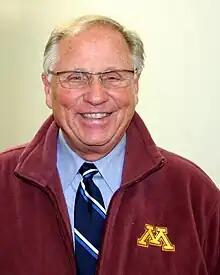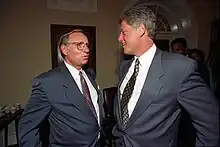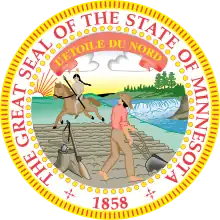Arne Carlson
Arne Helge Carlson (born September 24, 1934) is an American politician who served as the 37th governor of Minnesota from 1991 to 1999. A Republican, Carlson's viewpoints are considered to be moderate. Prior to his governorship, he served as the Minnesota State Auditor from 1979 to 1991.
Arne Carlson | |
|---|---|
 Carlson in 2010 | |
| 37th Governor of Minnesota | |
| In office January 7, 1991 – January 4, 1999 | |
| Lieutenant | Joanell Dyrstad Joanne Benson |
| Preceded by | Rudy Perpich |
| Succeeded by | Jesse Ventura |
| 14th Auditor of Minnesota | |
| In office January 4, 1979 – January 7, 1991 | |
| Governor | Al Quie Rudy Perpich |
| Preceded by | Bob Mattson |
| Succeeded by | Mark Dayton |
| Member of the Minnesota House of Representatives | |
| In office January 5, 1971 – January 2, 1979 | |
| Preceded by | Thor Anderson |
| Succeeded by | Todd Otis |
| Constituency | 36th district (1971–1973) District 58B (1973–1979) |
| Member of the Minneapolis City Council from the 12th Ward | |
| In office 1965–1967 | |
| Personal details | |
| Born | Arne Helge Carlson September 24, 1934 New York City, New York, U.S. |
| Political party | Republican (1960–present) |
| Other political affiliations | Democratic (until 1960) |
| Spouses |
|
| Children | 3 |
| Education | Williams College (BA) |
Born into poverty in New York City, he attended the Choate Rosemary Hall preparatory school on a scholarship. After graduating from Williams College, he went to graduate school at the University of Minnesota. In his first race for elected office, Carlson ran for a seat on the Minneapolis City Council in 1965 as a Republican. Winning the election, he served until 1967. With the Republicans in the majority, Carlson also served as city council majority leader. He ran for Mayor of Minneapolis in 1967 against incumbent Democratic mayor Arthur Naftalin. Carlson lost the close election.
He went on to serve in the Minnesota House of Representatives from 1971 until 1979. Carlson then was the Minnesota State Auditor from 1979 until 1991. He launched a bid for the Republican nomination for governor of Minnesota in 1990. He lost the primary election to businessman Jon Grunseth. However, Grunseth became embroiled in a scandal weeks before the election causing Carlson to take his place on the ballot. He defeated incumbent governor Rudy Perpich. In 1994, he easily won reelection to a second term. Since his return to private life in 1999, he has been an active supporter of Democratic candidates but remains a Republican.
Early years, education and family
Born in New York City, Carlson is the son of Swedish immigrants from Gothenburg and Visby. Carlson attended New York City public schools P.S. 36[1] and DeWitt Clinton High School in the Bronx before gaining a scholarship to attend The Choate School (now Choate Rosemary Hall) in Wallingford, Connecticut.[2] He earned a Bachelor of Arts degree in history from Williams College in 1957 before taking graduate courses at the University of Minnesota.[3][4]
Career
Early career
Carlson served one term on the Minneapolis City Council from 1965 to 1967, and was the Republican candidate for mayor in 1967, losing to Democratic-Farmer-Labor incumbent Arthur Naftalin. He was a member of the Minnesota House of Representatives from January 1971 to January 4, 1979. In 1978, he ran for and was elected state auditor. He was reelected in 1982 and 1986, serving in that position from January 4, 1979, to January 7, 1991. As State Auditor, Carlson worked to create uniform accounting for cities, counties, townships, and special districts, making Minnesota a leader in uniform accounting. He also overhauled the State's multi-billion dollar pension investment portfolio to allow private sector management, which significantly improved the rate of return.
Election in 1990
Carlson's long tenure as auditor, in addition to his noted speaking abilities, made him a leading contender for the Republican nomination in 1990. However, although he initially led in public opinion surveys, his status as a moderate Republican or even liberal Republican made him unpopular among party activists.[5][6] They instead backed Carlson's primary rival, businessman Jon Grunseth, a younger and more right wing candidate who had never held elected office.[5]
In the Republican primary, Grunseth defeated Carlson, who came in second place.[5] In 1990 general election polling, Grunseth was the favorite to defeat the incumbent governor and DFL nominee, Rudy Perpich, who was the state's longest-serving governor.[6][5] However, a scandal arose in mid-October, three weeks before the general election, after the Star Tribune published a front-page article with an account that, in 1981, Grunseth had invited three then-teenaged friends of his stepdaughter, as well as his stepdaughter herself, to go skinny-dipping in the pool at his home.[7] Although three of the four girls corroborated the report, Grunseth denied any improper conduct, and suggested that the allegations were orchestrated by Perpich.[5][6]
On October 15, 1990, with fifteen days of campaigning left before Election Day, Carlson revived his campaign for governor as a write-in candidate, and took part in an unusual three-way debate broadcast by Twin Cities Public Television,[6][5] which became the highest-rated locally produced program in the station's history.[8] Grunseth initially refused to drop out, thus splitting the Republican vote and providing an opportunity for Perpich to run for reelection. Nine days before the election, however—after vacillating for days and after another Star Tribune article, reporting that Grunseth had a lengthty extramarital affair—Grunseth withdrew. As the runner-up in the primary, the Independent-Republican Party Executive Committee declared Carlson the Republican nominee.[5][6][7][9] Five days before the election, in a 5–2 decision, the state Supreme Court ruled that Carlson was eligible to appear on the ballot In the November 6, 1990 general election, Carlson defeated Perpich by 3.3 percentage points, 50% to 47%.[5][6][8]
Tenure

Carlson was elected the 37th governor of Minnesota in the November 1990 general election, and served from January 7, 1991, to January 4, 1999. He won as a member of the Independent-Republican Party. In September 1995, the party changed its name to, simply, the "Republican Party."
During his administration, Carlson worked to solve an inherited $2 billion state budget deficit. By the end of his term, the state had surpluses of $2.3 billion in FY1997 and $1.9 billion in FY1998. His administration restored the AAA bond rating from all three Wall Street major bond houses and was the first such state to receive the upgrade in 25 years.
Carlson increased funding for elementary and secondary education by nine percent, created a top level Children's Cabinet to develop a single integrated agenda and budget for all state children's programs and initiatives, laid the groundwork for the first light rail in Minneapolis with state and federal funding of $160 million and was successful in getting school choice funded which was hailed by the "Wall Street Journal" as a model for the rest of the country.
In 1993, Carlson served as Chairman of the Midwestern Governors Association. That same year he signed into law the Minnesota Human Rights Act, which banned LGBT discrimination in housing, employment, and education.[10]
In 1994, the delegates to the Minnesota Republican Party State Convention viewed Carlson, who supported gay rights and abortion rights, as liberal. The party's right wing dominated the selection of convention delegates, and at the June 1994 convention Carlson won only 29% of the votes at the state Convention, with Allen Quist, a figure popular among grassroots Christian right activists, winning 69% of the delegates' votes.[11][12] Carlson described Quist as a "cult leader with a Messianic complex"[12] and in the September 1994 state primary, Carlson and running mate Joanne Benson won renomination by a 2:1 margin, with the endorsement of business groups, every major newspaper in the state, and the Teamsters union.[13] Carlson won the November 1994 general election by a large margin, 63% to 34%, over Democratic candidate John Marty.
As governor, Carlson was known as a fan of the University of Minnesota and its sports teams; his official portrait in the Minnesota State Capitol shows him wearing a letter jacket from the school. Carlson also worked closely with the President of the University of Minnesota, Mark Yudof, in improving the University's physical plant and in 1998, proposed and secured passage of an historic capital improvement package for all higher education with $206 million earmarked for the University of Minnesota. That led to projects ranging from building a molecular and cellular Biology Center to major renovations and upgrades to Walter Library.
Post-governorship
In 1998, after leaving office, Carlson was appointed to the board of directors of the IDS Mutual Fund Group, which was part of the American Express Financial Advisors, a Minneapolis-based company.[14] He was named chairman and CEO of the board the next year.[15]
Carlson has remained politically active in retirement. On 2010, he announced that he would embark on a "Paul Revere" tour of Minnesota to bring attention to fiscal problems facing the state.[16] During the 2011 Minnesota state government shutdown, which occurred after Democratic Governor Mark Dayton and the Republican state legislative leaders could not agree on a budget, Carlson collaborated with Walter Mondale and several other prominent political and business leaders to propose a nonpartisan budget commission.[17]
In 2001, in a MPR-St. Paul Pioneer Press Poll Carlson ranked second (behind Hubert Humphrey) among prominent Minnesota political figures on their contributions to the state. Fifty-seven percent of those surveyed said Carlson made a "great or major contribution" to the state.[18]
In retirement, Carlson often endorsed Democratic and DFL candidates over Republican candidates. He endorsed Barack Obama in the 2008 presidential election.[19][20] In 2016, Carlson endorsed Democratic presidential candidate Hillary Clinton over Donald Trump.[21][22] Carlson endorsed Democratic nominee Joe Biden over Trump in the 2020 presidential election.[23] He endorsed Tim Walz over Randy Demmer in the 2010 election to Congress,[20][24] and the same year broke with his party to endorse Independence Party candidate Tom Horner in Minnesota's gubernatorial race[25] and Tim Walz for Congress. In December 2010, as part of a post-election party purge of moderates, the Minnesota Republican Party Central Committee narrowly voted to ban Carlson and 17 others from participating in party events for two years.[26]
Carlson was an outspoken critic of Joan Gabel's performance as president of the University of Minnesota.[27]
Carlson and Mondale also teamed to oppose a voter identification amendment to the state constitution in the 2012 election.[28] The amendment was defeated.
Carlson is a longtime campaign finance reform proponent. He is a member of the ReFormers Caucus of Issue One,[29] and criticized the impacts of the Supreme Court's Citizens United decision. In 2012, Carlson teamed up with his former rival, John Marty, to support legislation that would prohibit corporations with more than 20% foreign ownership from donating to political campaigns, and to require board of directors or executive councils to approve political contributions made by the corporation or union (rather than allowing executives or presidents to unilaterally make such contributions).[30]
Personal life
Carlson was married to Barbara Carlson (née Duffy) from 1965 to 1977. After their divorce she became known in her own right as a Minneapolis City Councilwoman and a talk show personality. Together, they had a son, Tucker (no relation to the media personality), and two daughters, Kristin (deceased) and Anne, who has two children, Drew and Allie Davis. Carlson's second wife was Joanne Chabot. They had no children. After their divorce, he married Susan Shepard, with whom he has a daughter, Jessica. Susan served as First Lady of Minnesota from 1991 to 1999.
Electoral history
- 1994 race for Governor
- Arne Carlson (I-R) (inc.), 63%
- John Marty (DFL), 34%
- 1990 race for Governor
- Arne Carlson (I-R), 50%
- Rudy Perpich (DFL) (inc.), 47%
- 1986 race for State Auditor
- Arne Carlson (I-R) (inc.)
- John Dooley (DFL)
- 1982 race for State Auditor
- Arne Carlson (I-R) (inc.), 55%
- Paul Wellstone (DFL), 45%
- 1978 race for State Auditor
- Arne Carlson (I-R), 52%
- Robert W. Mattson Jr. (DFL) (inc.), 47%
References
- "PS 36 Unionport - Homepage". January 29, 2016. Archived from the original on January 29, 2016.
- "An Alternative to Public Schools When They Go Bad". New York Daily News. September 12, 1997.
- "Arne Helge Carlson". National Governors Association. January 3, 2011. Retrieved June 29, 2020.
- root. "Arne Helge Carlson". www.nga.org. Retrieved February 2, 2018.
- Gilbert, Curtis (November 5, 2010). "Recent race tame compared to 1990 gubernatorial contest". Minnesota Public Radio.
- 20 years ago: A three-week political roller coaster, Minnesota Public Radio News (November 5, 2010).
- "Republican Quits Minnesota Governor's Race". Los Angeles Times. Associated Press. October 29, 1990.
- Randy Furst, Did a TV debate decide one of Minnesota's most scandalous elections?, Star Tribune (September 2, 2022).
- "Minn. nominee quits gov's race". USA Today. October 29, 1990. Archived from the original on March 30, 2009.
- Preston, Joshua. "Allan Spear and the Minnesota Human Rights Act." Minnesota History 65 (2016): 76-87.
- Mary R. Sandok, Conservative Minnesota Republicans Refuse to Back Governor at Convention, Associated Press (June 18, 1994).
- Dan Balz, Minnesota GOP opts for conservative, denies Gov. Carlson Its endorsement, Washington Post (June 18, 1994).
- Minnesota Governor Prevails, Washington Post (September 14, 1994).
- Gov. Carlson named to IDS board, Minneapolis/St. Paul Business Journal (November 9, 1998).
- Arne Carlson appointed chairman, CEO of IDS Mutual Fund Board, Minneapolis/St. Paul Business Journal (March 2, 1999).
- Gov. Arne Carlson on Paul Revere tour, Minnesota Public Radio.org (June 2, 2010).
- Rachel Weiner (July 5, 2011). "Walter Mondale to help end Minnesota shutdown". The Washington Post. Retrieved July 5, 2011.
- "MPR: Poll: Ventura retains popularity". news.minnesota.publicradio.org. Retrieved September 6, 2023.
- Kaszuba, Mike (October 23, 2008). "Carlson endorses Obama, spurred by Bachmann remarks". Star Tribune. Archived from the original on October 28, 2008. Retrieved October 25, 2008.
- Former Gov. Carlson endorses Walz, Star Tribune (October 24, 2010).
- Mullen, Mike (June 15, 2016). "Why former Gov. Arne Carlson, Republican, is voting for Hillary Clinton". City Pages. Archived from the original on June 18, 2016. Retrieved July 2, 2016.
- ormer Gov. Arne Carlson, A Republican, Says He's Voting For Clinton, CBS Minnesota (August 7, 2016).
- Three Minnesota Republicans back Biden over Trump, Forum News Service/St. Paul Pioneer Press (August 24, 2020).
- Tom Scheck (October 25, 2010). "Arne Carlson backs Walz". Minnesota Public Radio. Archived from the original on October 26, 2010. Retrieved October 25, 2010.
- Arne Carlson endorses Tom Horner for governor Archived September 21, 2010, at the Wayback Machine. MinnPost. Retrieved on February 14, 2016.
- Hohmann, James (December 11, 2010). "Minnesota GOP brings out the knives for moderates". Politico.
- Cathy Wurzer and Ellen Finn, Fmr. Gov. Arne Carlson reacts to Joan Gabel leaving U, Minnesota Public Radio (April 3, 2023).
- ‘Teammates’ Walter Mondale and Arne Carlson find common ground on causes Archived August 20, 2012, at the Wayback Machine. MinnPost. Retrieved on February 14, 2016.
- "ReFormers Caucus - Issue One". 2023.
- Cyndy Brucato, Carlson, Marty plan bill to limit Citizens United decision, MinnPost (February 28, 2012).
